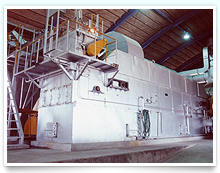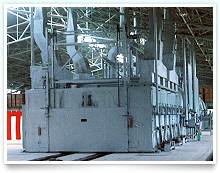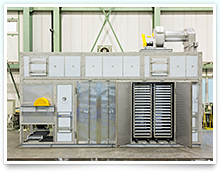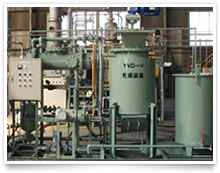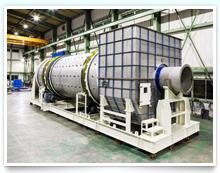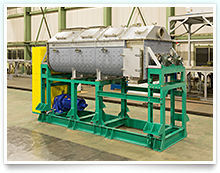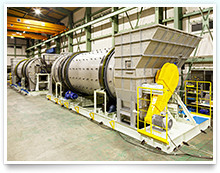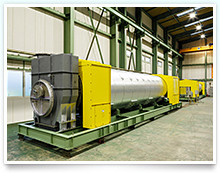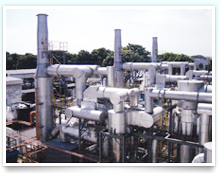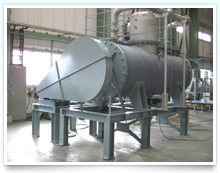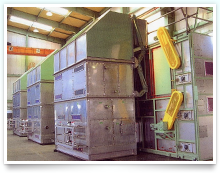
Sludges are treated through a dewatering process before disposal. However, in many cases, the sludge
has a high water content, which makes handling difficult and is problematic for both recycling and
disposal. When sludge drying technology is used for processing such sludges, the volume of the sludge
can be reduced and the sludge can be recycled, which enables running costs and disposal costs to be
reduced.
Sludge drying technology also enables sludge to be used as resources such as dried biofertilizers, by-product composite fertilizers and sludge fertilizers. Compared to the direct sludge drying method that dries sludge with direct flames and extremely high temperatures, the indirect drying method produces dried sludge that contains more plentiful organic matter, which is highly desired in agriculture.
Sludge containing organic matter includes food residue and soil attached to vegetables. Sludge drying brings out this organic matter and can increase the effective utilization of dried sludge for products such as fertilizers and snow melting agents. Therefore, from an ecological perspective as well, sludge drying technology is an extremely useful technology.
ypes of sludge drying technology include granulation drying, hot oil reduced-pressure drying,
and reformed sludge drying.
● Low moisture content results in less odors than raw sludge, and excellent storability with no degeneration, even when stored for a long time under conditions where moisture is not absorbed.
● The organic components in the product are concentrated in the granulated dry pellets, therefore the potential heat amount is usually higher than carbonized products.
● Product safety is about the same as other carbonized fuel products and sludge dried fuel products, and dust explosibility is also good.
● The composition of the sludge is modified to increase the reduction ratio of oxygen molecules, which improves the fuel characteristics.
■Granulation drying The granulation drying method makes use of the stickiness of sludge, by applying a thin film of sludge to dried granules (core granules), performing tumbling granulation of the sludge, and drying the sludge with hot air. This operation evaporates the moisture, therefore in general, the organic matter in the dewatered sludge is not broken down.
The granulation drying system is comprised of two processes. In the granulation process, the dewatered sludge and circulating dry sludge are granulated by mixing and kneading them with a twin shaft mixer. In the drying process, the sludge is dried with hot air of about 450℃ inside the drying drum. The granulated dry sludge is classified by the classifier, and only granules of the specified diameter are discharged as product pellets. The remaining granulated dry sludge is returned to the granulation process as circulating dry sludge.
In addition, the sludge drying gas is heated by the heat exchanger and circulated. Some of the gas is always drawn into the condenser to maintain a certain evaporation moisture, and after moisture is condensed, the gas is sent to the hot air generation furnace for combustion deodorization. The main features of the products obtained by this system are as follow.
● Gray-colored exterior and excellent handling.
● Low moisture content results in less odors than raw sludge, and excellent storability with no degeneration, even when stored for a long time under conditions where moisture is not absorbed.
● The organic components in the product are concentrated in the granulated dry pellets, therefore the potential heat amount is usually higher than carbonized products.
■Hot oil reduced-pressure drying Hot oil reduced-pressure drying is a sludge drying method where dewatered sludge and waste food oil are mixed together and heated under reduced pressure to evaporate the moisture in sewage sludge quickly and efficiently.
The hot oil reduced-pressure drying system is one type of sludge drying technology. This system is comprised of a preheating tank that mixes dewatered sludge and waste food oil, a hot oil reduced- pressure type dryer, and an oil separator that separates the oil from the dried sludge. The moisture evaporated in the sludge drying process is collected by the mist catcher and reused in the heating of the sludge dryer. The main features of a sludge dryer using this system are as follows.
/ The exterior of the sludge dryer is black and the pellets are granular. / Excellent product safety due to sterilization by the high-temperature processing. / Because the process contains oil, about the same low heating value as coal is obtained, therefore the potential heat amount is usually higher than carbonized products or granulated sludge dried products. / Self-heating properties under environments with poor heat dissipation or oxygen-rich environments.
■Reformed sludge drying Reformed sludge drying is a technology where sewage sludge is first reformed to a highly dewatered state under conditions between carbonization and drying, and then the sludge is dried.
A reformed sludge drying system is mainly comprised of a reforming/cooling device, dewatering/drying device, and a wastewater treatment device. The loaded dewatered sludge is converted into a liquid by the reformer due to the hydrothermal reaction caused by the high-temperature steam. At the same time, some of the organic components are broken down to release oxygen and reform the sludge. Then, the sludge is dewatered by the sludge dehydrator and converted into a granular fuel product by the sludge dryer.
In addition, the filtrate generated by the dehydrator is processed in the anaerobic treatment tank. The methane gas is recovered and used as a supplementary fuel for the reforming boiler. The liquid after anaerobic treatment is processed by a vibrating NF membrane.
The thermal energy obtained from the cooler is recovered from the circulating heat medium oil and used as a heat source for the drying process. The main features of the products obtained by this system are as follow.
● The heating value is equal to or greater than dewatered sludge.
● Product safety is about the same as other carbonized fuel products and sludge dried fuel products, and dust explosibility is also good.
Sewage sludge is a concentrated biomass resource with quantitatively and qualitatively stable characteristics. Approximately 70% of the sewage sludge produced in Japan is reused, mainly as compost and raw materials for construction.
However, because there are issues for these applications in terms of treatment and disposal costs and demand stability, there is a need to develop long-term, stable applications. As a new application for sewage sludge, technology is being studied, and in some aspects has already been applied, to convert sewage sludge into a solid fuel as an alternative to coal.
The technology for converting sewage sludge into solid fuel produces fuel products from sewage sludge by using sludge drying or carbonization technology. The fuel products can be used as an alternative fuel to fossil fuels at facilities such as coal-fired power stations. As a result, this technology has great potential for reducing greenhouse gas emissions.
This reformed sludge drying fuel conversion technology reforms sludge through a hydrothermal reaction to produce a fuel product that is energy efficient and high quality. In this research, experiments were performed with the objective of developing technology for converting sewage sludge into biomass fuel by using reformed sludge drying. These demonstrated that the generated energy exceeded the input energy, and also evaluated the quality and safety of the fuel products that were produced.
The thermochemical reforming of the dewatered sludge by using high-temperature and high-pressure water has the following two functions.
● The dewaterability of sludge is improved to enable dewatering at low moisture content, which greatly reduces the sludge drying energy required for making the fuel products.
● The composition of the sludge is modified to increase the reduction ratio of oxygen molecules, which improves the fuel characteristics.
The processing temperature of reformed sludge drying is positioned between sludge drying technology and carbonization technology. Carbonization is a process where heating is performed in a low-oxygen or oxygen-free state to release moisture and adsorbed gas to initiate thermal decomposition and then generate carbon matter based on carbon.
In this process, the decomposition of the organic components progresses to create a state rich in fixed carbon. In addition, the drying operation evaporates the moisture, therefore in general, the organic components in the dewatered sludge are not broken down. In the case of reformed sludge drying, not only is moisture evaporated, but also some of the organic components in the dewatered sludge are also broken down. Volatile components are evaporated in normal thermal decomposition, but the process is performed under pressure in the hydrothermal reaction, therefore the volatile components remain dissolved in the supernatant liquid.
(Reference) "Guidelines for Sewage Sludge Energy Conversion Technology", "Overview of Technical Manual for Biomass to Fuel Conversion Technology for Sewage Sludge Based on Reformed Sludge Drying"


